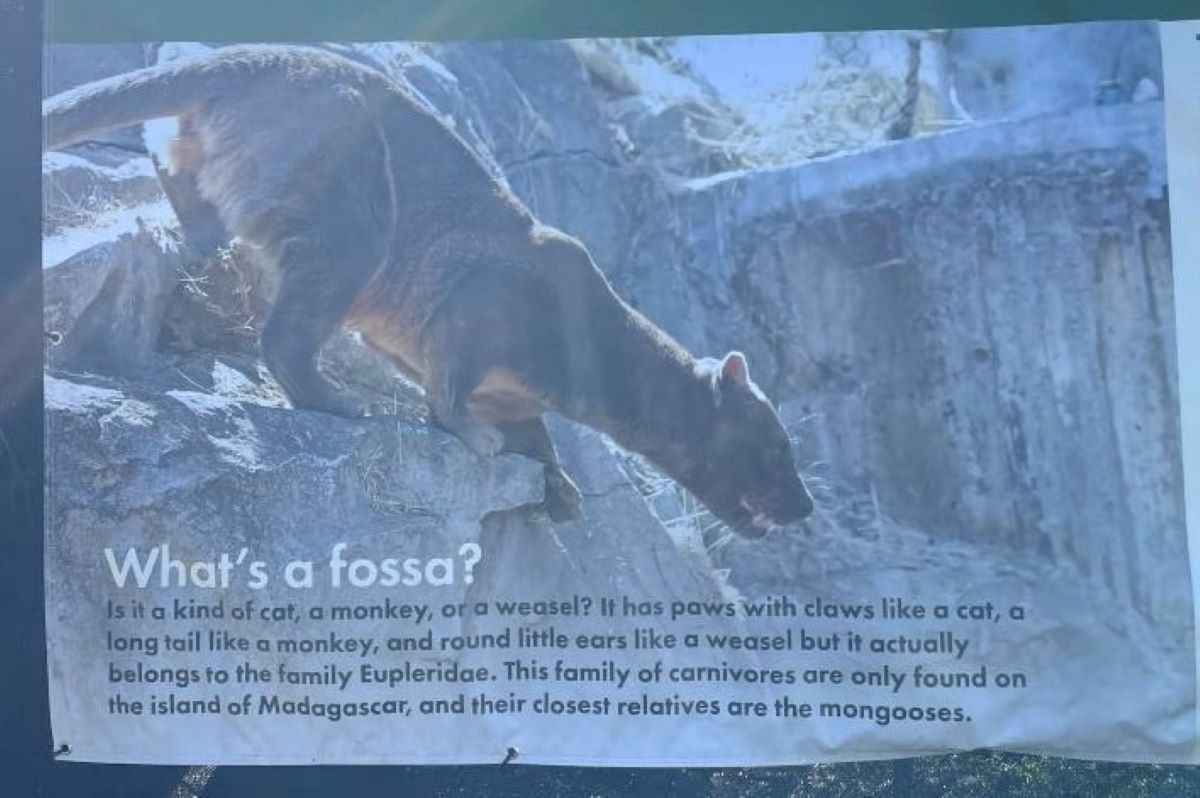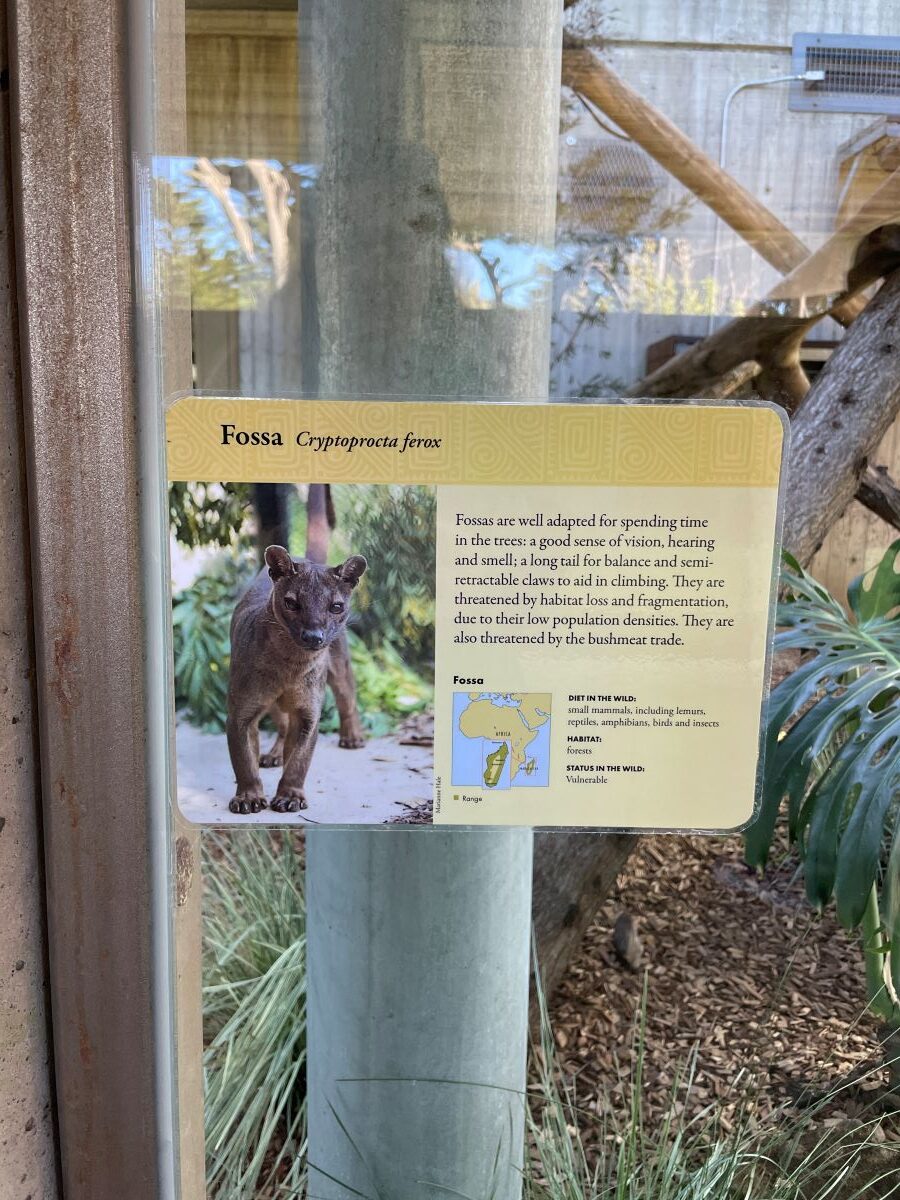
“OMG! It’s a Chupacabra!” I thought the first time I saw a fossa. It was during a recent jaunt to the San Francisco Zoo.
But then my brain checked itself. No one has ever captured a real Chupacabra, and if a zoo had one, surely that would’ve made the news.
Many have shared photos of alleged Chupacabras, though. Most sightings can be attributed to coyotes, foxes, or domestic dogs suffering from mange. But sometimes, Chupacabra sightings also accompany reports of dead animals that have died of mysterious circumstances and have been drained of blood. (Though, thankfully, this is a rare occurrence.)
Anyway, Chupacabra came to mind the second I saw the photo on the exhibit. I could see the animal but not its face. It was curled up sleeping with its head tucked upside down out of view.
But it wasn’t. According to the photo, its common name was fossa. But then I noticed its scientific name, Cryptoprocta ferox, and thought, “But it still is a type of cryptid!”
Fossas are members of the Eupleridae family.

My next thought was, “Wait. There are actual real animals with ‘crypto’ as part of their scientific names?”
Apparently. And I was seeing my first. (Or maybe it was more a matter of realizing it for the first time?)
According to the diet information, they’re definitely carnivores who feast on “small mammals, including lemurs, reptiles, amphibians, birds and insects.”
Thankfully “man” wasn’t on that list. It looked small and cute enough but that face… Well, it’s also a little terrifying. It’s got “predator” written all over it.
I’m sure the lemurs who live across the way in the zoo’s Lemur Forest are glad it’s in its own enclosure, too. (Which, speaking of the lemurs, there’s a super cool elevated boardwalk for viewing them. It was one of my favorite parts of the zoo.)
Fossas also hail from the same place as lemurs: Madagascar. And while they look, and in some cases act, like cats, monkeys, or weasels, their nearest relatives are mongooses.
But the thing I liked best was its scientific name. Now I’m on a mission to see just how many animals have “crypto” in theirs. I’ll report back with a list in a new post once I find out. If you know any, feel free to leave a comment sharing it, though!
Fun Facts about Genus Cryptoprocta
I’m really hung up on this “crypto” classification so I did some research on “Cryptoprocta,” which led me to a fossa taxonomy fact sheet at the San Diego Zoo Wildlife Alliance. Under “Etymology,” it explained the origin of the genus Cryptoprocta, which made me realize I was obsessing about the wrong “end” of things. (As you’ll see, since the emphasis is on the “-procta.”)
Anyway, Cryptoprocta comes “from two Greek words krypto meaning “to hide or to conceal” and proktos meaning “anus.” (Now do you see what I mean by the wrong end?)
But then it went on to further specify that the “name refers to the obscuring of the animal’s anus which is hidden by an anal pouch.”
Huh. Interesting.
And under “Cultural History,” there was a “Mythology and folklore” section that explained local people consider eating fossas “fady,” or taboo.
Then, under “Popular cultural resources,” it referenced an article with a title that couldn’t help but catch my eye, “The Fossa: Ghost Animal of Madagascar” by Clyde A. Hill. It was published in September 1968, issue 9, of the journal ZOONOOZ (now the San Diego Zoo Wildlife Alliance Journal).
For More Info
In addition to the San Francisco Zoo, here’s a list of other zoos that house fossas. To view a list that includes international zoos, visit Zoo Institutes.
Bronx Zoo – New York
Capital of Texas Zoo – Wyldwood, Texas
Catoctin Wildlife Preserve – Thurmont, Maryland
Central Florida Zoo & Botanical Gardens – Sanford, Florida
Cincinnati Zoo & Botanical Garden – Ohio
Cleveland Metroparks Zoo – Ohio
Happy Hollow Park & Zoo – San Jose, California
Houston Zoo – Texas
Little Rock Zoo – Arkansas
San Antonio Zoo – Texas
San Diego Zoo – California
Staten Island Zoo – New York
The Living Desert Zoo & Gardens – California
Zoo Atlanta – Georgia
Check-In
Have you ever seen a fossa? Do you live in a state with a zoo that has one?
Courtney Mroch is a globe-trotting restless spirit who’s both possessed by wanderlust and the spirit of adventure, and obsessed with true crime, horror, the paranormal, and weird days. Perhaps it has something to do with her genes? She is related to occult royalty, after all. Marie Laveau, the famous Voodoo practitioner of New Orleans, is one of her ancestors. (Yes, really! As explained here.) That could also explain her infatuation with skeletons.
Speaking of mystical, to learn how Courtney channeled her battle with cancer to conjure up this site, check out HJ’s Origin Story.

I have seen a fossa! I’m trying to remember which zoo. Um, the D.C. zoo? I’m not sure! Weird about the anus pouch. I wonder how they empty it… ew.?
OMG Priscilla, you had me LOLing while trying not to spit out my coffee! And once again saying to myself, “I’m so shocked I didn’t wonder the same thing!” LOL My Google search history is going to get really weird with the addition of “how to empty an anal pouch.” (Because you know now I have to know! lol) Wonder if fossas and others like them are little stinkers thanks to those pouches? lol Thanks as always for the comment but in this case the bonus laughter!